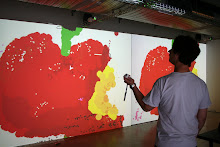Patrick Tresset found me on linkedin.com and sent me a link to his latest press release. "I think our respective researches share some concerns." This project is swell and is worth a mention.
"Aikon 2 Project launched at Goldsmiths, University of London
Published: 23 February 2009 10:00
How can an artist draw with an immediately recognisable style, in a particular manner?
And how, and why, can a few lines thrown spontaneously on paper be aesthetically pleasing?
A bold project using computational techniques to examine the activity of drawing - in particular sketching the human face - has been launched at Goldsmiths, University of London.
The AIKON (Autonomous/Artistic/IKONograph) Project has received funding from the Leverhulme Trust to carry out work from 2009 until the end of 2011, and could eventually result in AIKON ‘learning’ to draw in its own style.
The project is being co-ordinated by Professor of Computing at Goldsmiths, Frederic Fol Leymarie and Patrick Tresset, a researcher and artist who has already carried out much work in the area upon which the AIKON Project will build.
Artistic drawing has been practiced in every known civilisation for at least the last 30,000 years and sketching specifically has the particularity of showing the drawing process complete with its hesitations, errors and corrections.
The area of research has been tackled by art historians, psychologists, neuroscientists - such as Arnheim, Fry, Gombrich, Leyton, Ramachandran, Ruskin, Willats and Zeki - who have argued that artists organise their
perception of the world differently.
The AIKON Project will follow two main research paths: one starts from the study of sketches in archives and notes left by artists and the other is based on contemporary scientific and technological knowledge.
Professor Fol Leymarie explains more about the project: “Even if still partial, the accumulated knowledge about our perceptual and other neurobiological systems is advanced enough that, together with recent progress in computational hardware, computer vision and artificial intelligence, we can now try to build sophisticated computational simulations of at least some of the identifiable perceptual and cognitive processes involved in face sketching by artists.”
The most important processes to be studied and simulated within AIKON include the visual perception of the subject, and the dynamically created sketch. It will also study the representation, planning and execution of the drawing gestures; the cognitive activity of reasoning, about the percepts of the sitter and the drawing; the influence of the years of training as a form of memory, and the inter-processes information flows, with a focus on feedback mechanisms - for example when looking back at the sitter or when looking at the partial sketch already performed.
Based on earlier work and results, Frederic and Patrick are expecting AIKON to be able to draw in its own style, with the resulting system having been informed by an artist's insights and also by past artists’ left writings about their creative behaviour."


No comments:
Post a Comment